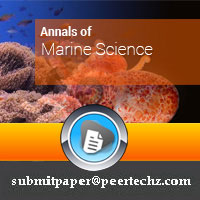Annals of Marine Science
Parasitoids of fly collected in urban area in Brazil
Carlos Henrique Marchiori*
Cite this as
Marchiori CH (2019) Parasitoids of fly collected in urban area in Brazil. Ann Mar Sci 3(1): 011-012. DOI: 10.17352/ams.000014Objective this study aimed to ascertain the species of parasitoids of Musca domestica L. (Diptera: Muscidae) and their biological characteristics that were collected in one area of City of Goiânia, State of Goiás in Brazil. Parasitoids were collected by exposing larvae of M. domestica and its breeding substrate (beef liver) outdoors, in containers filled with sand that were placed next to garbage containers. The study was from March to September 2015. Thirty-five (35) specimens of parasitoids were collected Pachycrepoideus vindemmiae (Rondani) (Hymenoptera: Pteromalidae) was the most frequent species, with 74.2%. This manuscript reports the first occurrence of Hemencyrtus sp. and Tachinobia sp. as solitary parasitoids in Goiás.
Introduction
Parasitoids are important regulators of insect populations and stand out as the main group of natural enemies in agricultural systems. They are present in various orders of insects and their adaptation to a parasitic behavior is seen most diversely and abundantly in the order Hymenoptera [1].
Another application of parasitoids may be related (besides biological control) to the study of Forensic Entomology which is the use of ecological data and development of necrophagous insect to estimate the postmortem interval in criminal investigations.
The objective of this study was to verify the parasitoid species of Musca domestica L. (Diptera: Muscidae) and their biological characteristics collected in an urban area in Brazil.
Materials and Methods
This experiment was conducted in the urban area near Botafogo River, Goiânia, Goiás, Brazil. Parasitoids were collected by exposing larvae of M. domestica and its breeding substrate (bovine beef liver) outdoors, in containers filled with sand that were placed next to garbage containers [2]. The parasitoids were collected by using four traps [3]. The following items were used as baits: human feces, cattle kidneys, cattle liver and fish which were placed inside the cans, over a layer of earth. To obtain the parasitoids, the contents of the traps were placed in plastic containers with a layer of sand for use as a substrate for transformation of the larvae into pupae [3].
Results and Discussion
From March to September 2015, 35 specimens of parasitoids were collected (Table 1). The number of specimens collected in urban areas was possibly due to greater food supply, to variations in the quality and availability of food resources.
The percentage parasitism of each parasitoid species was calculated by means of the number of pupae parasitized per species of parasitoid, divided by the total number of pupae from that host and multiplied by 100.
Pachycrepoideus vindemmiae (Rondani) (Hymenoptera: Pteromalidae) (Figure 1), was the most frequent species, with 74.2%. Since several species of parasitoids were collected in the same host, it is very likely that interspecific competition determined which species of parasitoid would emerge in greater quantity, as well as the remainder would have been eliminated by competition.
These proportions are related to the search capacity and the seasonal variation in parasitoid levels. Pachycrepoideus vindemmiae had the highest percentage of parasitism. Perhaps its greater competitive potential in the larval stage can explain this fact.
Pachycrepoideus vindemmiae is a parasitoid that controls a great number of Diptera in the families Anthomyiidae, Calliphoridae, Muscidae, Sarcophagidae, Tachinidae and Tephritidae. This species presents diversified (cosmopolitan) distribution and it has been found in North America and Africa [5].
Table 2 shows the biological characteristics of the parasitoids of fly collected in Brazil. Majority were of parasitoids, larvae, solitary, endoparasitoids and Koinobionts. Most behave as and solitary forming small pupae, probably resulting from competition for food.
These insects are considered bioindicators for the biodiversity of ecosystems, and are considered as key species for maintaining the equilibrium of the communities in which they are included. In addition, since they are natural enemies of insects, they may be used in biological control programs of agricultural pests [4].
Definitions- Parasitoid larval oviposita inside the larva, but the adult or adults emerge from the puparium. Parasitoid pupal oviposita in the pupa and the adult or adults emerge from the puparium. Endoparasitoid: in them the larvae of the parasitoids develop inside the body of the host. Ectoparasitoid: larvae of parasitoids develop on the host. Solitary: is that a parasitoid out of each parasitized pupae. Gregarious species in a single host may occur the development of several individuals. koinobiont: allow the host to continue its development while feeding on it. Idiobiont: which inhibit any host activity and development at the time of parasitization.
This manuscript reports the first occurrence of Hemencyrtus sp. and Tachinobia sp. as solitary parasitoids in Goiás.
Conclusion
Thirty-five (35) specimens of parasitoids were collected. P. vindemmiae was the most frequent species, with 74.2%. In process of urbanization on parasitoids, they revealed that urbanization negatively affected or had no effect on parasitoids. Majority were of parasitoids, larvae, solitary, endoparasitoids and Koinobionts. This manuscript reports the first occurrence of Hemencyrtus sp. and Tachinobia sp. as solitary parasitoids in Goiás.
- Panizzi AR, Parra JP (2009) Bioecologia e nutrição de insetos. 1st Edition by Embrapa, Brasil. 1: 164
- Ferreira MJM (1978) Sinantropia de dípteros muscóideos de Curitiba, Paraná I. Calliphoridae.Rev Bras Biol38: 445-454. Link: http://bit.ly/2U3tiPX
- Marchiori CH, OM Silva Filho (2005) Microhimenópteros do gênero Spalangia (Hymenoptera: Pteromalidae: Spalanginae) coletados em vários substratos no Sul do Estado de Goiás, Brasil. Biotemas 18:.219-225. Link: http://bit.ly/2ZoiYTO
- Scatolini D, Penteado-Dias AM (1997) A fauna de Braconidae (Hymenoptera) como bioindicadora do grau de preservação de duas localidades do Estado do Paraná. Rev Bras Ecol1: 84-87.
- GauldID,BoltonB, Huddleston T, Fitton MG, Mark RS, et al. (1988) The Hymenoptera. Oxford: Oxford University Press UK. 1-132. Link: http://bit.ly/30Bjsay

Article Alerts
Subscribe to our articles alerts and stay tuned.
 This work is licensed under a Creative Commons Attribution 4.0 International License.
This work is licensed under a Creative Commons Attribution 4.0 International License.

 Save to Mendeley
Save to Mendeley
